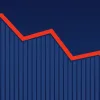Will We Ever See 3% Mortgage Rates Again?

It turns out that 2010 to 2020 were the golden years of homebuying.
If you had a job paying a median income, you could probably afford a home.
Mortgage rates averaged exactly 4.0% over the decade, says Freddie Mac, dropping to or below 3% at many points.
Home prices were low, recovering from the home price crash that started in 2007. Affordability was the best it had been since 1977 according to the DQYDJ Home Affordability Tool.
People wonder if those days will ever return, specifically mortgage rates in the 3s that homebuyers enjoyed before 2022.
Let’s find out if 3% rates may come back someday.
What Needs to Happen For 3% Rates to Return?
There’s always a chance that rates in the 3s could return. History has proven that it’s possible. But economic conditions would have to mirror those present during periods of low rates.
Low Inflation

Image: U.S. Bureau of Labor Statistics, Consumer Price Index for All Urban Consumers: All Items Less Food and Energy in U.S. City Average [CPILFESL], retrieved from FRED, Federal Reserve Bank of St. Louis; June 21, 2024
Inflation averaged just 1.8% annually from January 2010 to January 2021, says the U.S. Bureau of Labor Statistics. The most recent reading in May 2024 was 3.4%, nearly double last decade’s average. It was recently as high as 6.6%.
Inflation would have to be closer to 2% for mortgage rates to fall. Low inflation helps mortgage bond rates drop, and mortgage rates are tied to these bonds. It would also justify Fed rate cuts, which would provide an easier environment for rates to fall.
Aggressive Fed Action

Image: Board of Governors of the Federal Reserve System (US), Assets: Total Assets: Total Assets (Less Eliminations from Consolidation): Wednesday Level [WALCL], retrieved from FRED, Federal Reserve Bank of St. Louis; June 20, 2024
Perhaps the most important ingredient to ultra-low rates is the Federal Reserve’s heavy involvement in markets.
This means more than just cutting its benchmark rate, the federal funds rate. In response to financial crises, the Fed actively buys mortgage bonds and U.S. Treasury debt, driving down rates.
It’s called Quantitative Easing. The Fed leveraged this tool in 2008 in response to the housing crash and resulting economic downturn. It kept buying securities through 2014. Then COVID hit, and the Fed took the idea to new heights, doubling its holdings from $4.1 trillion in early 2020 to $8.9 trillion by March 2022.
To get back to what some view as unnaturally low rates, the Fed would have to spin up a new round of aggressive open market involvement.
High Unemployment

Image: U.S. Bureau of Labor Statistics, Unemployment Rate [UNRATE], retrieved from FRED, Federal Reserve Bank of St. Louis; June 17, 2024.
The economy is doing quite well, at just 4.0% unemployment. The 2010s saw an average unemployment rate of 6.4%, says the U.S. Bureau of Labor Statistics. The figure reached 10.0% during the housing crisis and 14.8% during COVID.
Low unemployment drives wage-push inflation. People can easily find higher paying jobs, so companies have to pay higher wages to attract and retain employees. They pass this cost onto consumers, driving up prices in the economy.
High unemployment has the opposite effect, driving down inflation and mortgage rates. Additionally, investors buy mortgage bonds, fearing a stock market downturn. More demand on mortgage bonds means lower rates for those bonds.
Low Mortgage Rates Require Worse Economic Conditions
To sum it up, the U.S. economy has to be in a much worse spot to see 3% mortgage rates again. Currently, the stock market is hitting new records, unemployment is ultra-low, and inflation is high. All this would have to change to see rock-bottom mortgage rates.
Are 3% Rates Even Normal?

Image: Freddie Mac, 30-Year Fixed Rate Mortgage Average in the United States [MORTGAGE30US], retrieved from FRED, Federal Reserve Bank of St. Louis; June 20, 2024
Though the public got used to rates in the 3s from 2010 to early 2022, they are not a normal occurrence.
Ultra-low rates first entered the scene due to the worst recession since the Great Depression – the housing crash of 2008. They hung around for a surprisingly long time, bouncing around but dropping back in the 3s by mid-2019. Then rates reached seemingly impossible lows during COVID.
Today’s dramatic rate increase is more of a return to normal, though they might feel ridiculously high.
According to Freddie Mac, 30-year fixed mortgage rates have averaged 7.73% since 1971, when the agency started tracking data. That’s nearly 1% higher than 2024’s year-to-date average of 6.87%.
Will rates go even higher to return to match historical norms? It’s possible. But the U.S. is also due for a recession, which could drive down rates, too.
Should you wait for lower rates to buy a home? It wouldn’t be wise. Remember that the economy has to falter for rates to fall significantly, especially to 3%. And if that happens, you may not have the income to qualify for those ultra-low rates.
Why 3% Rates Could Do More Harm than Good
Remember that double-digit unemployment spurred the last decade of low rates.
It’s better to have solid employment and high wages and a 7% mortgage than no job and a 3% home loan.
And remember that low rates will unleash enormous pent-up homebuying demand. Home inventory will again plummet and prices will skyrocket. It will be extremely difficult to find a home to buy.
If you’re waiting on the sidelines for that 3% rate to return, consider the benefits of higher rates: less competition for homes, steady employment, and the income to cover a larger house payment.
Tim Lucas is the editor and Lead Analyst for MortgageResearch.com. Tim spent 11 years in the mortgage industry and now leverages that real-world knowledge to give consumers reliable, actionable advice. He has been featured in national publications such as Time, U.S. News, MSN, The Mortgage Reports, and more.




